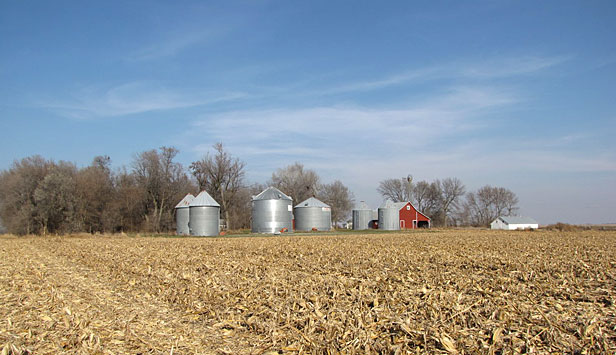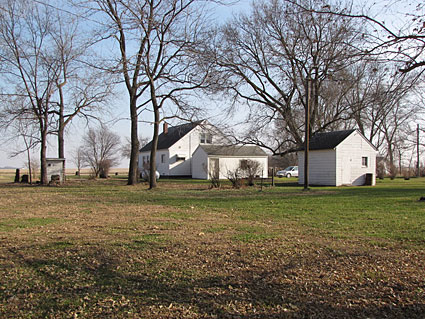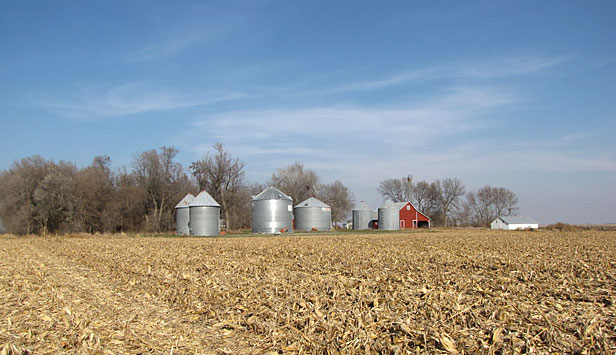 Our new farmhouse and outbuildings.Photos: Steph Larsen
Our new farmhouse and outbuildings.Photos: Steph Larsen
In Green Acreage, Steph Larsen chronicles the sprouting of a small but sustainable Nebraska property.
———————————
Last December, I bought the farm.
Clearly I mean this in the literal, not euphemistic, sense. (Although I’ve spent some time pondering why the phrase “bought the farm” means “to die,” but I digress.)
 The back of the farmhouse According to the legal survey, my farm is “12 acres, more or less,” meaning the surveyor measured off 12.006 acres and called it good. It has a cute farmhouse, six strong outbuildings, a grove of trees on the north and west sides, and 4.6 acres of ground formerly planted in a corn-soybean rotation that now has grass seeds sprouting in it.
The back of the farmhouse According to the legal survey, my farm is “12 acres, more or less,” meaning the surveyor measured off 12.006 acres and called it good. It has a cute farmhouse, six strong outbuildings, a grove of trees on the north and west sides, and 4.6 acres of ground formerly planted in a corn-soybean rotation that now has grass seeds sprouting in it.
I live in northeast Nebraska, where a “farm” is usually much bigger than 12 acres, and a “farmer” is typically a 59-year-old white man who grows corn and soybeans and/or raises cattle for a living. Folks around here would call my place “an acreage.” But I aim to grow enough food to feed myself and others in my community. Isn’t that what a farm does? So I’m calling it a farm, even if there are those who would object, and even if we haven’t come up with a name for it yet.
Buying this farm represents a plateau in a pursuit that started when I was a wide-eyed college student reading My Ishmael by Daniel Quinn. It dawned on me that the most rebellious, independent act I could commit against an unjust social and economic system was to grow my own food. I was pretty into rebellion then, but even as I’ve aged the idea hasn’t lost its shine.
Luckily I met an amazing life partner who doesn’t think growing things a crazy idea, and soon we were casually farm shopping. We were pretty picky — we wanted a sturdy house and barn, 10 to 20 acres, and nice land with a grove of trees within 5 miles from work. I really hoped for hardwood floors, but I’d have settled for linoleum if everything else fell into place.
We made offers on a few places. Meanwhile, friends and neighbors told us about a perfect place exactly 5 miles from our office. The first time I saw it, I fell in love. I held it up as the gold standard to every other house we looked at, even though it wasn’t on the market. The son of the owner wouldn’t sell “until Dad died,” and I wasn’t going to hope for that, so we kept looking.
When our banker called to say that the owner of “that perfect place” had passed on at age 97, I could only hope that his son listed the house at a price we could afford and with enough acres to satisfy us. He did, and so in the dead of the worst winter in 30 years (according to my neighbors, but we’ll see what they say next year), we moved to the country.
The legacy of the previous owners lives on in the apple trees, raspberry bushes, rhubarb patch, daffodils, and grape hyacinth that my partner and I now enjoy — as well as the surprises that keep popping out of the ground as the weather improves. We’ve tilled the garden, and already the peas, onions, kale and broccoli are making their debut. Tomatoes, peppers, eggplants and a host of other seedlings await the correct soil temperature in the room upstairs with a big south-facing window. Asparagus crowns went in a few weekends ago, followed by carrots, onions, and potatoes.
We’ve also planted 250 tree seedlings we ordered from our local Natural Resource District. Deciding which trees to order took a long time — we took stock of what we have in our grove and what we lack, what purpose we want the tree or bush to serve, and how much room we have. In the end, we got lilacs and dogwoods for a hedge to protect the garden from road dust and pesticide drift, red cedars for a living snow fence, Colorado blue spruce to fill in the shady gaps, and cottonwood and honey locust for firewood.
The red cedars and dogwoods came to us looking robust, while the blue spruce and honey locusts were hardly more than twigs. Fingers crossed that most of them make it, despite my tripping over them in the dark on the way to the chicken coop.
 We have 27 chicks, about 10 or 11 different breeds. They just made the big move from my basement to their new home in the coop. They’re adjusting fine, though their new enclosure within the coop is a wee bit drafty. I like it because one side was formerly a screen door we found in the barn, so I can sit on the floor and watch them instead of towering above. Sometimes, I get the feeling that they think of me as a big pair of black boots and some disembodied hands reaching down from the sky. No wonder they scatter if I move too quickly.
We have 27 chicks, about 10 or 11 different breeds. They just made the big move from my basement to their new home in the coop. They’re adjusting fine, though their new enclosure within the coop is a wee bit drafty. I like it because one side was formerly a screen door we found in the barn, so I can sit on the floor and watch them instead of towering above. Sometimes, I get the feeling that they think of me as a big pair of black boots and some disembodied hands reaching down from the sky. No wonder they scatter if I move too quickly.
I’ve already learned a lot about owning a farm in the few months I’ve been here, like how to drive our 1960s Farmall 460 tractor and the proper distance to stand from a chain saw being operated by someone else. (Answer: if there’s sawdust in my eyes, I’m too close.) I’ve found that grain bins look an awful lot like space capsules on the inside, and that baby chicks are only adorably cute for the first week.
We’ve been busy.
I have big plans for this farm. And who knows? Maybe by the end of this year, my farm will have grown enough to warrant a name — and I’ll have grown enough food to justify calling it a farm.
A version of this post appeared originally on The Blog for Rural America and is cross-posted on The Ethicurean.



